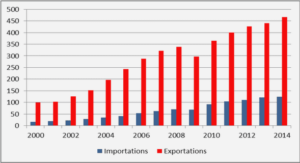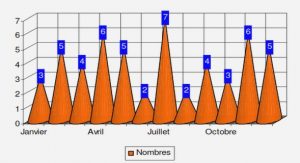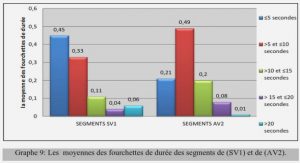Results
Structural model
After assessing the measurement model, the evaluation of the structural model should be the next step. Therefore, the variance explained (R2), path coefficient, effect size (f2) and predictive relevance (Q2) were used to evaluate the structural model (see Table 7). R2 is a measure of a model’s overall predictive power (Hair et al., 2014a)445, described as weak (0.25), moderate (0.50) and substantial (0.75). A bootstrapping procedure (5000 samples) was applied in this study to estimate, using t-values, the significance of the path coefficients. According to Cohen (1988)446, the difference between the variance explained for the main effects model and for the interaction effects model can be used to determine the strength of moderating effects (f2 = [R2 (Interaction effects model) ‒ R2 (Main effects model)]/[1 ‒ R2 (Interaction effects model)]). Additionally, effect sizes of 0.02, 0.15 and 0.35 are small, medium and large, respectively (Cohen, 1988)447. The redundancy (Q2), however, is “an indicator of the model’s predictive relevance” (Hair et al., 2014a, p. 178)448. Q2 values higher than zero show that the endogenous constructs seem to have satisfactory predictive relevance. In a recent study, Tenenhaus et al. (2005)449 propose a new criterion for PLS, namely, goodness-of-fit (GoF), to assess how well the data fits the research model. GoF is calculated as the geometric mean of the average communality (measurement model) and the average R2 value (structural model), as described in Table 9. When GoF values are equal to 0.1, 0.25 and 0.36, they are considered small, medium and large, respectively (Wetzels et al., 2009)450.
Soft drinks
Table 9 presents the estimates of the path coefficients and the explained variances (R2) of the structural model. Model 1 shows that satisfaction explains 46.2 percent of the variance in trust, whereas both satisfaction and trust explain 43.9 percent of the variance in loyalty.
R2 values of 0.462 and 0.439 can be seen as weak-moderate. The results of this study indicate that satisfaction (c’ = 0.278, t = 5.039, p < 0.001) and trust (b1 = 0.442, t = 8.332, p < 0.001) have a significant effect on loyalty; thus H1 is supported. In addition, satisfaction significantly impacts trust (a = 0.680, t = 21.904, p < 0.001). The effect of trust on loyalty seems to be greater than the effect of satisfaction on loyalty. As the level of satisfaction and trust increases, customers are likely to be loyal to soft drink brands.
Therefore, these factors play an important role in enhancing and developing loyalty. The Q2 values show that the endogenous constructs of the main effects model (Q2 trust = 0.342 > 0; Q2 loyalty = 0.252 > 0) and the interaction effects model (Q2 trust = 0.342 > 0; Q2 loyalty = 0.280 > 0) have acceptable predictive relevance (see Table 10). According to the results in Table 9, the GoF value of 0.452 indicates a good fit of the full model, i.e., interaction effects model, to the research data. Model 2 includes the moderating variables as independent variables, which leads to increasing the R2 value of loyalty from 0.439 to 0.489. The path coefficients between satisfaction and loyalty and between trust and loyalty are c’ = 0.246 (t = 4.408, p < 0.001) and b1 = 0.356 (t = 6.812, p < 0.001), respectively, whereas the path coefficient between satisfaction and trust is a = 0.680 (t = 22.723, p < 0.001). Moreover, consumer innovativeness (b2 = 0.150, t = 3.539, p < 0.001) and relationship proneness (b4 = 0.203, t = 5.184, p < 0.001) significantly impact loyalty, while the effect of variety-seeking on loyalty is not significant (b3 = 0.040, t = 0.973, n.s.). However, these relationships were not hypothesized in this study. In addition, this study demonstrates the mediating effect of trust on the relationship between satisfaction and loyalty. Therefore, to evaluate the mediating effect of trust, Table 11 shows that the indirect effect of satisfaction on loyalty via trust is significant (ab1 = 0.242, t = 6.322, p < 0.001). The direct effect of satisfaction on loyalty, without including trust as a mediator, is statistically significant (c = 0.488, t = 11.617, p < 0.001). Subsequently, when trust is included as a mediating variable, the direct effect of satisfaction on loyalty decreases but remains significant (c’ = 0.246, t = 4.408, p < 0.001). The VAF, however, has a value of 0.495, which indicates partial mediation. Thus, it can be concluded that trust has a partial mediating effect on the relationship between satisfaction and loyalty, which supports H2.
This conclusion suggests that high consumer satisfaction leads to greater trust and that high trust leads to high customer loyalty. These results emphasize the important role of trust in explaining the nature of the relationship between satisfaction and loyalty. Model 3 tests the moderating effects of consumer innovativeness, variety-seeking and relationship proneness on the relationship between trust and loyalty. The R2 value for loyalty is 0.492. The results show that the moderating effects of consumer innovativeness (b5 = 0.054, t = 1.121, n.s.), variety-seeking (b6 = 0.031, t = 0.552, n.s.) and relationship proneness (b7 = 0.025, t = 0.352, n.s.) on the relationship between trust and loyalty are not significant. Thus, H3, H4, and H5 are not supported. These results suggest that trust, regardless of the three personality traits, can play a vital role in explaining the nature of the relationship between satisfaction and loyalty. Therefore, enhancing customer satisfaction leads to enhancing trust, which leads to improving customer loyalty.
Fruit juices
As seen in Table 9, model 1 shows that trust and loyalty present R2 values of 0.412 and 0.588, respectively, which suggests that satisfaction can explain 41.2 percent of the variance in trust, while both satisfaction and trust can explain 58.8 percent of the variance in loyalty. R2 values of 0.412 and 0.588 are considered weak-moderate and moderatesubstantial, respectively. Satisfaction was found to have a significant positive effect on trust (a = 0.642, t = 15.833, p < 0.001) and loyalty (c’ = 0.459, t = 9.896, p < 0.001), supporting H1. This result reveals that consumers with a higher level of satisfaction show higher levels of trust and loyalty to fruit juice brands. Trust has a significant positive effect on loyalty (b1 = 0.387, t = 8.676, p < 0.001), suggesting that a higher level of trust leads to a higher level of customer loyalty. Customer satisfaction has a stronger influence on customer loyalty than trust does. Thus, it seems that satisfaction and trust are key factors that influence customer loyalty. The Q2 values show that the endogenous constructs of the main effects model (Q2 trust = 0.312 > 0; Q2 loyalty = 0.383 > 0) and the interaction effects model (Q2 trust = 0.312 > 0; Q2 loyalty = 0.427 > 0) have acceptable predictive relevance (see Table 10). To evaluate the GoF of the structural model, the GoF value of 0.512 indicates a good model fit with the research data (see Table 9). Model 2 includes the moderating variables as independent variables, which leads to increasing the R2 value of loyalty from 0.588 to 0.656. The results show that there is a positive and significant relationship between satisfaction and loyalty (c’ = 0.395, t = 9.604, p < 0.001), and between trust and loyalty (b1 = 0.298, t = 6.648, p < 0.001). Satisfaction was also found to have a positive impact on trust (a = 0.642, t = 16.893, p < 0.001). Moreover, variety-seeking (b3 = 0.079, t = 2.184, p < 0.05) and relationship proneness (b4 = 0.272, t = 7.195, p < 0.001) significantly impact loyalty, whereas the relationship between consumer innovativeness and loyalty is not significant (b2 = 0.013, t = 0.360, n.s.).
These relationships, however, were not hypothesized in this study. H2 predicts that the relationship between satisfaction and loyalty is mediated by trust. As shown in Table 11, satisfaction has a significant indirect effect on loyalty via trust (ab1 = 0.191, t = 5.908, p < 0.001), and the VAF has a value of 0.325. These results indicate that trust has a significant partial mediating effect on the relationship between satisfaction and loyalty.
Hence, H2 is supported. In other words, consumers who are satisfied have a certain level of trust that increases their loyalty to fruit juice brands. Model 3 tests the moderating effects of consumer innovativeness, variety-seeking and relationship proneness. The R2 value of loyalty slightly increased from 0.656 to 0.664 after introducing the moderating variables. Therefore, the moderating effect size presents a value of 0.024, which is considered small (see Table 12). The results show that variety-seeking has a negative moderating effect on the relationship between trust and loyalty, with a path coefficient of 0.110 (t = 3.016, p < 0.01). More specifically, the influence of trust on loyalty decreases when variety-seeking increases. A possible explanation for this result is that consumers with a low level of variety-seeking tend to remain and develop long-term relationships with the same brands (familiar brands). In contrast, consumer innovativeness (b5 = 0.030, t = 0.864, n.s.) and relationship proneness (b7 = 0.029, t = 1.024, n.s.) have no moderating effects on the relationship between trust and loyalty, which means that consumer innovativeness and relationship proneness are not moderators of the relationship between trust and loyalty. These results thus show that H4 is supported, whereas H3 and H5 are not supported.
Mineral water
As can be seen from the results in Table 9, model 1 indicates that 55.6 percent of the variance in loyalty was explained by trust and satisfaction, and 52.2 percent of the variance of trust was explained by satisfaction. R2 values of 0.556 and 0.522 are both moderate-substantial. In addition, there is a positive relationship between satisfaction and loyalty (c’ = 0.578, t = 10.289, p < 0.001) and between trust and loyalty (b1 = 0.212, t = 3.579, p < 0.001). Satisfaction influences trust significantly (a = 0.722, t = 20.161, p < 0.001). Therefore, H1 is supported. The results show that satisfaction is the most important predictor of customer loyalty. The Q2 values show that the endogenous constructs of the main effects model (Q2 trust = 0.442 > 0; Q2 loyalty = 0.378 > 0) and the interaction effects model (Q2 trust = 0.442 > 0; Q2 loyalty = 0.440 > 0) have acceptable predictive relevance (see Table 10). As presented in Table 9, the GoF has a value of 0.578, which is greater than 0.36 (large). This indicates that the research model fits the data well. Model 2 includes the moderating variables as independent variables, which leads to increasing the R2 value of loyalty from 0.556 to 0.648. Satisfaction has a significant positive influence on loyalty (c’ = 0.417, t = 7.759, p < 0.001). Trust has a significant impact on loyalty (b1 = 0.148, t = 2.968, p < 0.01). The relationship between satisfaction and trust is also significant (a = 0.722, t = 19.534, p < 0.001). Furthermore, relationship proneness is positively and significantly related to loyalty (b4 = 0.370, t = 8.085, p < 0.001), whereas consumer innovativeness (b2 = 0.007, t = 0.187, n.s.) and variety-seeking (b3 = 0.017, t = 0.411, n.s.) show no significant impact on loyalty, though these relationships were not hypothesized in this research. Table 11 presents the results of direct, indirect and total effects of satisfaction on loyalty through trust. Regarding hypothesis H2, satisfaction was found to have a significant indirect effect on loyalty through trust (ab1 = 0.107, t = 2.808, p < 0.01). Table 11 also shows that the VAF has a value of 0.204, indicating partial mediation. That is, trust partially mediates the relationship between satisfaction and loyalty, supporting H2. Model 3 examines whether consumer innovativeness, variety-seeking and relationship proneness moderate the influence of trust on loyalty. The R2 value of loyalty slightly increased from 0.648 to 0.653 after the introduction of moderating variables. Accordingly, no significant effect size was found (f2 of 0.014 is less than the minimum threshold of 0.02) for the moderating effects (see Table 12). Finally, results indicate that consumer innovativeness (b5 = 0.098, t = 1.763, p < 0.05) has a positive and significant moderating effect on the relationship between trust and loyalty. This result, however, is not in line with the proposed hypothesis. Hair et al. (2011)464 indicate that paths that are insignificant or do not show the same signs as the considered hypothesis must be rejected. Therefore, H3 is not supported. Variety-seeking (b6 = 0.066, t = 1.173, n.s.) and relationship proneness (b7 = 0.011, t = 0.309, n.s.) have no moderating effects on the relationship between trust and loyalty. Hence, H4 and H5 are not supported.
Yogurt
R2 values and path coefficients are presented in Table 9. Model 1 shows that satisfaction and trust explain 51.4 percent of the variance in loyalty, whereas satisfaction explains 59.7 percent of the variance in trust. R2 values of 0.514 and 0.597 are described as moderate-substantial. The path coefficients show that both satisfaction (c’ = 0.369, t = 7.116, p < 0.001) and trust (b1 = 0.392, t = 6.336, p < 0.001) have a significant positive impact on loyalty, supporting H1. These results show that satisfaction and trust are the most important predictors of loyalty. Among the two predictors of customer loyalty, trust seems to have the greatest impact on loyalty. Satisfaction, however, positively and significantly impacts trust (a = 0.773, t = 26.430, p < 0.001), suggesting that consumers who have a higher level of satisfaction are more likely to have a higher level of trust. The Q2 values show that the endogenous constructs of the main effects model (Q2 trust = 0.492 > 0; Q2 loyalty = 0.332 > 0) and the interaction effects model (Q2 trust = 0.492 > 0; Q2 loyalty = 0.379 > 0) have acceptable predictive relevance (see Table 10). From the results shown in Table 9, the GoF value of 0.554 indicates a good model fit. Model 2 includes the moderating variables as independent variables; this leads to increasing the R2 value of loyalty from 0.514 to 0.591. The results of path coefficients show that satisfaction has a positive impact on trust (a = 0.773, t = 26.951, p < 0.001), which, in turn, has a positive impact on loyalty (b1 = 0.316, t = 4.808, p < 0.001). Satisfaction has a positive influence on loyalty (c’ = 0.277, t = 5.219, p < 0.001). Moreover, consumer innovativeness (b2 = 0.032, t = 0.835, n.s.) and variety-seeking (b3 = 0.001, t = 0.021, n.s.) have no significant impact on loyalty, whereas relationship proneness positively and significantly impacts loyalty (b4 = 0.312, t = 7.379, p < 0.001). These relationships were not hypothesized in this study. Table 11 presents the results of the mediating effect of trust on the relationship between satisfaction and loyalty. The results show that the indirect effect of satisfaction on loyalty via trust is significant (ab1 = 0.244, t = 4.938, p < 0.001). The VAF presents a value of 0.468, which suggests that the effect of satisfaction on loyalty is partially mediated by trust, thus supporting H2. Model 3 tests the moderating effects of consumer innovativeness, variety-seeking and relationship proneness on the relationship between trust and loyalty. After adding the moderating variables, the R2 value of loyalty increased from 0.591 to 0.601. Therefore, the difference between R2 values provides an effect size f2 of 0.025, which is considered a small effect size (see Table 12). The results show that relationship proneness significantly moderates the relationship between trust and loyalty (b7 = 0.087, t = 1.945, p < 0.05) in a way that supports H5. This means that the positive relationship between trust and loyalty increases when the level of relationship proneness increases. There is no significant moderating effects of consumer innovativeness (b5 = 0.010, t = 0.240, n.s.) and variety-seeking (b6 = 0.012, t = 0.256, n.s.) on the relationship between trust and loyalty. Thus, H3 and H4 are not supported.
|
Table des matières
ACKNOWLEDGEMENTS
ABSTRACT
GENERAL INTRODUCTION
Background of the Study
Research Questions and Objective of the Study
Organization of the Study
CHAPTER I. LITERATURE REVIEW AND TRUST MODELS
Introduction
Section 1. Literature Review
1.1 Consumer-Brand Relationship
1.2 Trust in Consumer-Brand Relationship
1.3 Relationship Trust and Other Quality Variables
1.4 The Moderating Role of Personality Traits
Section 2. Trust Models
2.1 Different Trust Models in Consumer-Brand Relationship
2.2 The Relationship between Trust and Satisfaction
2.2.1 Satisfaction and Trust are Independent from each Other
2.2.2 Trust is an Antecedent of Customer Satisfaction
2.2.3 Satisfaction is a Predictor of Trust
CHAPTER II. CONSTRUCTS, MODEL AND HYPOTHESES
Introduction
Section 1. Research Constructs
1.1 Brand Satisfaction
1.2 Brand Trust
1.3 Brand Loyalty
1.4 Consumer Innovativeness
1.5 Variety-Seeking
1.6 Relationship Proneness
Section 2. Model Development and Hypotheses
2.1 Conceptual Framework
CHAPTER III. RESEARCH METHODOLOGY
Introduction
Section 1. Data Collection and Measurement
1.1 Sample and Data Collection
1.2 Measurement Scales
1.2.1 Likert-Type Scales
1.2.2 Construct Measures
Section 2. Data Analysis Method
2.1 Partial Least Squares Structural Equation Modeling (PLS-SEM)
2.2 Measurement Model
CHAPTER IV. RESULTS AND DISCUSSION
Introduction
Section 1. Results
1.1 Structural Model
1.1.1 Soft Drinks
1.1.2 Fruit Juices
1.1.3 Mineral Water
1.1.4 Yogurt
1.2 Between-Group Differences
Section 2. Discussion
2.1 General Discussion
Summary
CONCLUSIONS AND MANAGERIAL IMPLICATIONS
Conclusions
Managerial Implications
Limitations and Future Research
REFERENCES
APPENDICES
Appendix A. Questionnaire on Consumer Perceptions and Preferences of Food Brands in Algerian Market (English, Arabic and French Versions)
Appendix B. Number of Brands Mentioned in each Participant’s Set
Appendix C. Evoked Set
Appendix D. Questionnaire (English, Arabic and French Versions)
Appendix E. Multi-Group Comparison Results
LIST OF FIGURES
LIST OF TABLES
TABLE OF CONTENTS
![]() Télécharger le rapport complet
Télécharger le rapport complet





